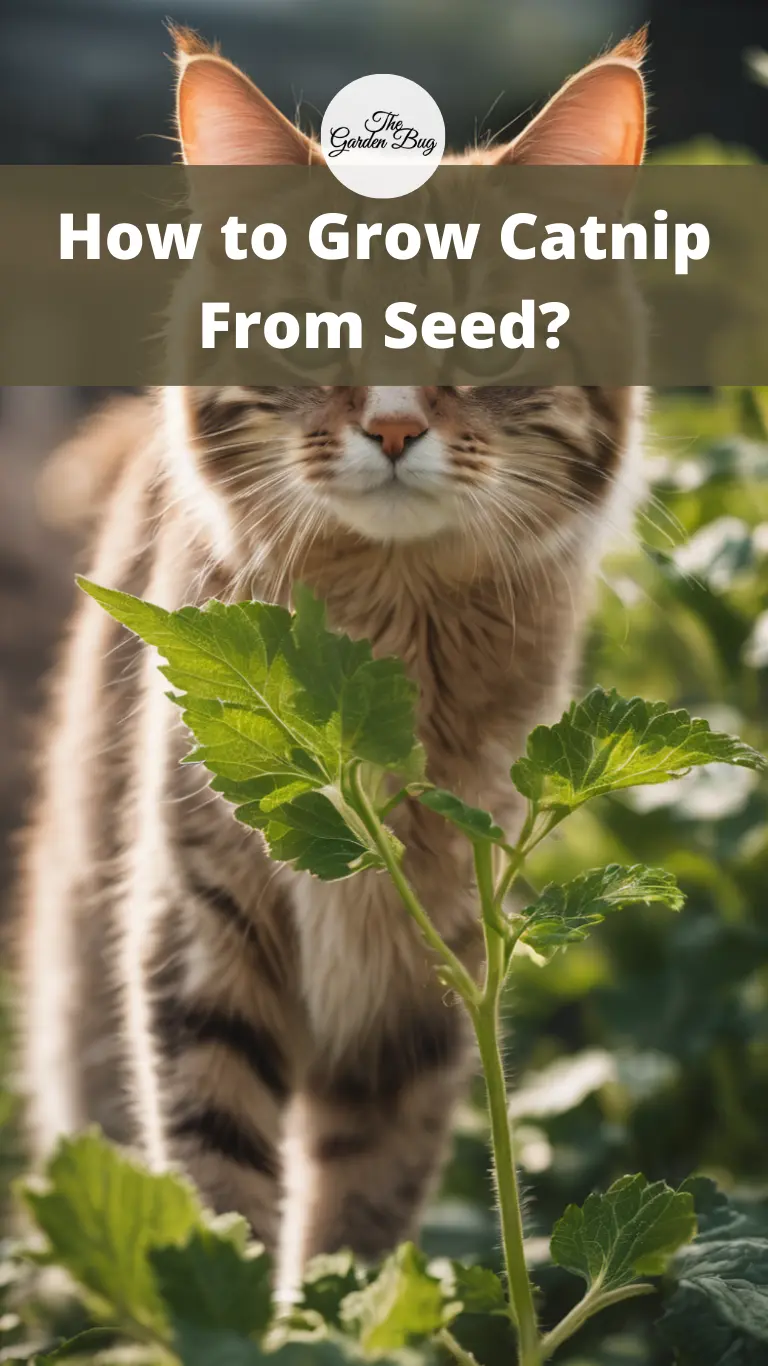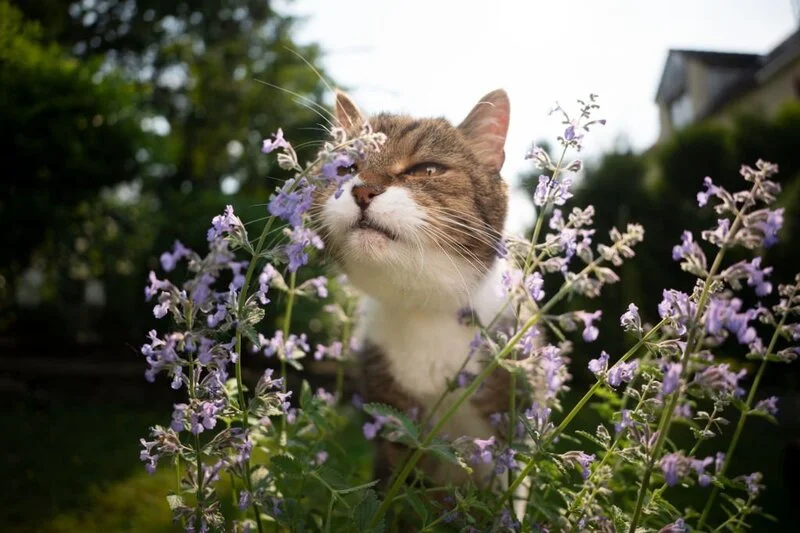Let’s talk about catnip! Do you have a curious cat that loves to play? Or are you just a gardening enthusiast who enjoys growing different types of plants? Either way, you’ve made a purr-fect choice. This magical herb not only acts as a kitty magnet but also adds a charming touch to your garden with its lovely flowers and fragrance. Let’s explore the world of growing catnip from seed.
- Happy Cat – Pamper your cat with this happy cat collection. Most cats absolutely love the herb Catnip. This plant contains nepetalactone oil which gives most cats a sense of euphoria and intense happiness.
- Healthy Cat – Cat Grass grown from 100% Sweet Oats will help keep your cat healthy by providing fiber and natural trace elements such as vitamins A and D. It’s much safer for your cat than eating the grass outside.
- 100% Natural – Know exactly what you are giving your cat by growing your own Catnip and Cat Grass. These seeds are 100% natural and the plants will be safe for your cat to smell, chew, or play with. Two packets of Cat Grass and one packet of Catnip.
- Easy to Grow – Instructions included on each packet. Plus, we are available to answer all your questions. If these seeds don’t germinate, we will happily make it right for you.
- Safe and Sustainable – Our operation is fully solar powered, and Sow Right Seeds has taken the Safe Seed Pledge to sell only fresh Non-GMO heirloom seeds for you and your family.
Catnip and Its Growth Requirements
Catnip, scientifically known as Nepeta cataria, is a member of the mint family and is adored by our feline friends. It’s often recognized by its heart-shaped, soft, fuzzy leaves and its spike-like clusters of white or lavender flowers.
But what does catnip need to grow happily? For starters, it’s a hardy plant that loves a sunny spot with well-draining soil. It can grow in partial shade as well, but the more sun it gets, the more potent its aroma becomes, which is, after all, the secret to its kitty-attraction power. In terms of temperature, catnip can withstand cold down to USDA hardiness zone 3, but it thrives best in zones 4-9. Understanding these factors will ensure you get off to a great start with your catnip growing adventure!
Getting the Right Seeds and Tools
The first step to growing your catnip garden is gathering the right seeds and tools. You can find catnip seeds in most gardening stores or online. When selecting seeds, remember that freshness matters. Fresh seeds have a higher germination rate, meaning more of them will sprout into plants.
As for the tools, you’ll need a pot or a garden bed depending on where you want to grow your catnip. You’ll also need some quality potting soil or garden soil, and a watering can. If you’re growing your catnip indoors, make sure you have a sunny spot for your plants. Alright, we have our seeds and tools, let’s move to the exciting part – planting!
- SUPERIOR INDOOR PLANT FERTILIZER – MARPHYL Marine Phytoplankton is ideal as an outdoor and indoor plant fertilizer. It’s an excellent vegetable fertilizer, houseplant fertilizer, and lawn fertilizer. It’s great for your garden, greenhouse, and hydroponics. Enjoy gorgeous, colorful blooms with this exceptional flower food. Enhance soil quality and watch your trees, shrubs, vines, grass, plants, flowers, and vegetables thrive.
- NATURAL INDOOR PLANT FOOD – Marine Phytoplankton are Microalgae full of nutrients, vitamins, and minerals. It’s so much more than your average liquid plant fertilizer. MARPHYL’s fertilizer for indoor plants and outdoor plants, grasses, trees, flowers and more, provides an astounding array of nutritional elements. Packed with vitamins, minerals, essential fatty acids, DHA, EPA, amino acids, chlorophyll, and a vast spectrum of phytochemicals, so your lawn, garden, and greenhouses will flourish
- ORGANIC & SUSTAINABLE – Our Liquid Marine Phytoplankton Soil Enhancer is an organic, all purpose plant food that is harvested 100% naturally. It’s vegan, non-toxic, non-GMO & sustainably made with no preservatives making it safe for vegetable gardening, ground water, and pets. It replenishes your soil on a regular basis to ensure the continued growth and beauty of your vegetation. Our organic plant fertilizer will meet your every need and provide a safe environment for all gardening.
- MIRACULOUS & BENEFICIAL – Found in oceans across the world, marine phytoplankton are micro algae that infuse your plants, trees, grasses, and more with everything they need for health and longevity. High in potassium, nitrogen, and phosphorus as well as calcium and magnesium for lush foliage. Your lawn & garden will be the envy of the neighborhood, and your indoor plants will brighten your home.
- EASY TO USE WATER SOLUBLE FERTILIZER – Simply mix a 1:20 ratio of our liquid plant fertilizer with water. Once in the water, stir, and then pour onto the plants. Perfect for use in small and large sprayers. Recommended use is every two weeks. You’ll see the difference after just one application!
Step-by-Step Guide to Planting Catnip Seeds
- Begin by filling your pot or garden bed with soil. Make sure to leave about an inch of space from the top if you’re using a pot.
- Spread the catnip seeds over the soil. Remember, catnip plants like their personal space, so try not to crowd too many seeds together.
- Cover the seeds with a thin layer of soil. Catnip seeds like to be just lightly covered. Don’t bury them too deep.
- Water the newly sown seeds gently. The soil should be moist but not waterlogged. Catnip seeds don’t like to be too wet.
- Place the pot in a sunny location or, if you’ve planted the seeds in a garden bed, make sure the spot gets plenty of sun.
- Wait for your seeds to sprout. This usually takes between 7 to 10 days. Keep the soil moist but remember not to overwater.
- Once your catnip plants are about 5 inches tall, you can thin them out. This means removing some plants to give the remaining ones more room to grow. Aim for about 15 to 20 inches of space between each plant.
There you have it – a simple guide to planting your very own catnip from seeds! Next, let’s dive into how to care for these charming plants as they grow.
Transplanting and Maintaining Mature Catnip Plants
As your tiny catnip plants grow bigger, they might need a new home. If they are in a pot, it’s time to give them a bigger one or put them in the ground. This step is called ‘transplanting.’ Do this gently, making sure you don’t hurt their roots. The best time for transplanting is early spring or fall.
Once in their new home, your catnip plants will need regular care. Water them regularly but remember, no over-watering. They like their soil just right – not too dry, not too wet. And remember that sunny spot? Keep them there. Catnip plants love the sun!
Also, consider giving them some plant food or compost every now and then. This will keep them healthy and help them produce the aromatic leaves your cats love so much. And speaking of cats, if yours can’t resist the plants, consider putting a small fence around them.
- Miracle-Gro Indoor Potting Mix feeds houseplants for up to 6 months and is designed to be less prone to gnats (contains no compost or bark, which are known to shelter fungus gnats)
- This potting mix contains coconut coir, which holds and releases water and helps soil re-wet
- Blended potting soil for a wide variety of indoor container plants, including climbing, foliage, flowering, and tropical plants
- To use this indoor soil, fill a container about 1/3 full with potting mix; add more mix after placing your plant in the pot
- One 6 qt. bag of Miracle-Gro Indoor Potting Mix fills four 6-inch containers (exact amounts may vary depending on the size of the root ball)
Common Problems and Solutions when Growing Catnip from Seeds
Sometimes, despite our best efforts, plants can get sick. Some common problems with catnip include leaf spots and root rot. Leaf spots are usually because of fungus and can be treated with a fungicide. Root rot is often a result of over-watering. If you notice your catnip plant’s leaves turning yellow, cut back on watering.
Another common problem is pests, like aphids and whiteflies. If you notice these bugs on your plants, you can use a natural insecticide or introduce beneficial insects, like ladybugs, to your garden.
Conclusion
Growing catnip from seeds is a fun and rewarding experience. With a little bit of care and patience, you can cultivate a lush catnip garden that will make your feline friends purr with joy. It might seem tricky at first, but don’t worry. You got this! Remember, gardening is all about learning and growing, just like your plants.







